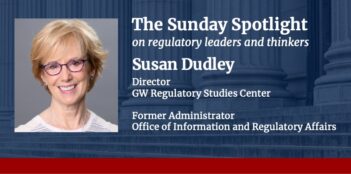
OMB’s draft Circular A-4 in places provides vague guidance that lets ideology—not evidence—drive regulatory design.
This spring, the Office of Management and Budget (OMB) released a draft version of revisions to Circular A-4, a document that gives guidance to federal departments and agencies on regulatory analysis and policy. The release of revisions to Circular A-4 is a welcome development, especially because the document has not been revised for two decades. Yet as scholars of regulated industries, we have concerns with certain aspects of the proposed reforms, which we initially highlighted in comments submitted to OMB in June 2023. This essay draws from those comments to offer our assessment of how OMB might strengthen its final guidance on regulatory analysis, particularly with respect to economic regulation.
The draft Circular A-4 makes a number of positive changes with respect to regulatory design. It asks regulators, for the first time, to consider market power in their analysis of both the need for regulation and the benefits and costs of regulatory actions. This is an important shift. Not all markets are the same; not all markets are competitive; and regulatory actions can sometimes entrench—or break down—market power. The draft Circular A-4 also asks departments and agencies to consider the degree of compliance from industry. Rather than simply assume that a regulation will lead to full compliance, agencies are now asked to consider whether the regulatory action will lead to under-, over-, or full compliance. This is also a critically important shift. Different regulatory designs could have wildly different likelihoods of compliance. Regulatory effectiveness cannot simply be assumed.
At the same time, however, OMB should revise sections of the draft Circular A-4 that express overbroad advice on regulatory design, perhaps more for legacy ideological reasons than empirical ones.
The section on “performance standards, rather than design standards” advises agencies that “performance standards are often superior to engineering or design standards.” This statement is astonishing, given that scholars have observed that there is little to no evidence either that performance standards are effective, as a general matter, or that performance standards are systematically more effective than design standards. Indeed some have even observed that—contrary to this proposition—design standards can sometimes be essential in achieving regulatory goals.
The draft Circular A-4 guidance on performance and design standards may also create a conflict with the draft Circular A-4’s important statements on compliance. As OMB observes, not all regulatory designs will achieve full compliance, and agencies should consider the degree to which regulated entities will comply with the regulation in their analysis. In any given case, an agency should assess what level of compliance it anticipates a regulatory action could have and consider that information in its overall assessment of regulatory alternatives. This careful, neutral approach is contrary to a blanket preference for performance standards over design standards.
A second example of overbroad regulatory design guidance is the draft Circular A-4’s comments on economic regulation. The draft Circular A-4 states that, “in light of both economic theory and actual experience, it is particularly difficult to demonstrate positive net benefits for any of the following types of regulations,” and then it specifies “prices controls in well-functioning competitive markets,” “production or sales quotas in well-functioning competitive markets,” “mandatory uniform quality standards,” and “controls on entry” except for health, safety, and common property resources.
This paragraph suffers from specific flaws and, more broadly, insufficiently addresses the arguments for public utility-style regulation, rather than offering a careful analysis of these regulatory tools and their tradeoffs.
First, the paragraph’s claim that it is “particularly difficult to demonstrate positive net benefits” is not supported by a citation or by evidence in the draft. It is hard to see how OMB—or anyone—could make such a conclusory statement in the absence of a considerable body of up-to-date evidence, when the benefit-cost analysis might differ widely in different situations. As a recent National Academy of Sciences report has observed, comparisons among regulatory designs and strategies “can only be made in the context of the conditions under which a regulation will be applied and in reference to the particular problem it is intended to address.”
Second, the specific bullet on entry-restriction outlines only a few justifications for that policy tool: health and safety, and common property resources. This statement is too narrow. Textbook justifications for entry restriction also include preventing destructive competition and ensuring that a regulatory system prevents cream skimming and enables cross subsidies. Indeed, this regulatory tool is also used currently in statutory law in a number of different sectors for reasons that are broader than those outlined in this statement.
Third and more broadly, the section on economic regulation does not go into detail on the purposes of economic regulation, the situations in which it might be effective, the ways that economic regulation tools interact, or the wide range of benefits that economic regulation can yield. It is framed instead as offering broad opposition to economic regulation as a tool, except in narrow situations, such as when there are not “well-functioning competitive markets” or when “voluntary standards” or disclosure rules are not “adequate.” This language offers little guidance to agencies and is particularly puzzling given the draft Circular A-4’s approach to compliance and market power.
Economic regulation was designed in part as an antimonopoly tool—a way to address areas in which firms have considerable market power. In light of the draft Circular A-4’s inclusion of market power issues, the cursory and narrow treatment of economic regulation is problematic. The draft Circular does not note that economic regulation tools may be particularly appropriate in network and utility industries; it does not outline the many specific tools of economic regulation; and it does not observe that individual tools may be useful even if the full suite of economic regulation tools is not needed. The lack of a sophisticated discussion of economic regulation is particularly stark when compared to the draft Circular’s section on nudges, which runs more than a page in helping agencies understand that regulatory tool.
Draft Circular A-4’s treatment of economic regulation tools also feels out of step with its new and commendable emphasis on considering the distributional effects of regulations. As economic regulation has withered, particular parts of the country have suffered disproportionate impacts in terms of the loss of key infrastructure services, such as rail and airlines, and the failure to develop others, such as broadband. The draft Circular itself suggests that these considerations may be relevant to regulatory design, yet it says nothing about the possible benefits of applying economic regulation tools to address these distributional effects. Here, as elsewhere, revisions to the draft are necessary, especially given developments in our understanding of economic policy and regulation over the last twenty years.
OMB’s revision should strive to offer a neutral, careful assessment of regulatory design tools, especially in light of changing historical context and lessons learned over the past two decades. Skepticism toward “economic regulation” was part of a broader ideological and historical moment in which neoliberal economic ideas were ascendant. Foundational scholarly articles that criticized economic regulation have since been debunked, including by ideological fellow travelers.
The most recent scholarly textbook in the field of “regulated industries,” of which we are two of the co-authors, identifies significant downsides to deregulation in many sectors in the form of reduced system resilience, exacerbated geographic inequality, and increased market concentration, among other impacts. In some cases, the downsides of deregulation or the failure to adopt economic regulation have only become clear in the last two decades, suggesting that the retention of inherited 2003 claims about “actual experience” may be unwarranted or, at least, unnecessarily casual. Indeed, OMB’s emphasis on market power in the draft Circular A-4 is one example. Economic deregulation in many sectors—including airlines, maritime shipping, railroads, banking, and telecommunications—has contributed to market consolidation.
Rather than make blanket conclusions about regulatory tools that are disconnected from purposes, evidence, or context, OMB should advise agencies to consider and evaluate the benefits and costs of regulatory proposals neutrally. Absent statutory direction, evidence—not ideology—should drive regulatory design. OMB should revise Circular A-4’s sections on performance standards and economic regulation either by deleting them and replacing them with a detailed analysis of these regulatory tools, or by taking a more neutral approach overall that asks agencies simply to evaluate all design strategies in context and in light of the specific situation and conditions, without putting a thumb on the scale in favor of one approach over another.





